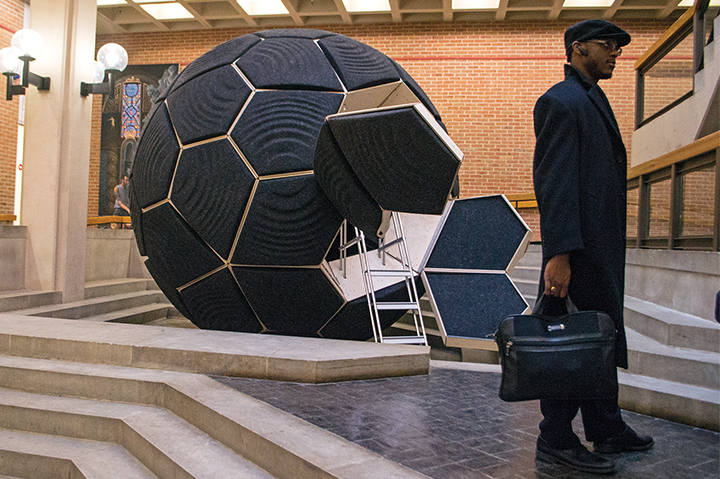
Tony Belton, a junior sociology major, stands next to the “Chamber, 2014” exhibit in the Art-Sociology building. The display aims to disorient those who enter.
On a busy campus filled with noises and passersby, it can be difficult to find a moment to be alone with one’s thoughts. That’s not the case in a 12-foot sphere that resembles a soccer ball in the Art-Sociology Atrium.
“Chamber, 2014,” a felt-and-wood structure composed of a series of pentagonal and pyramidal cells fixed together that opened yesterday, cuts off all senses and stimuli to leave visitors with only their thoughts.
Designed by Massachusetts Institute of Technology professors Joel Lamere and William O’Brien Jr., the darkened anechoic chamber was assembled the first weekend in February and is the result of a partnership between the architecture school’s Kibel Gallery, the architecture program, the university’s Art Gallery, the art department and the Design | Cultures + Creativity honors program.
Chamber, on display through March 7, is open to any visitor looking for a removed, peaceful experience amid the chaos of daily life, Lamere said.
“It’s basically meant to completely disorient you in a certain way, in order to allow a person to go in and experience only themselves as opposed to all of the other kind of constant feedback and input that we get in our everyday existences,” Lamere said.
Chamber leaves visitors with only their thoughts, Lamere said. The dark, strikingly quiet sphere slightly rocks on its base to prevent visitors from establishing a consistent gravitational orientation. Only one person can enter at a time, and the sphere’s opening cannot be closed from the inside, requiring someone to shut the visitor inside, said Ronit Eisenbach, Kibel Gallery chairwoman.
“It leaves you in, I think, in a very unsteady place, but an unsteady and hopefully very self-reflective kind of place,” said Eisenbach, an architecture professor.
Chamber cost about $20,000 to construct, Lamere said, and it was funded partly through a grant from the Council of Art at MIT. Lamere and O’Brien funded the remainder.
The two started working on Chamber in the summer of 2012. They had the idea and a lot of felt, Lamere said, but they struggled to find the right venue, so the project lay dormant for about a year.
Lamere asked Eisenbach if she knew of a place where Chamber could be displayed. Eisenbach suggested assembling the structure in the atrium of the Art-Sociology building.
“When they approached us about whether there was a place in Maryland for it, we just felt that this was the place,” she said.
Although finding the right location for Chamber was initially a challenge, Lamere said the final location ended up being ideal.
“That atrium is just so perfect for it because the atrium has all of these kind of harsh angles and tons of interesting geometries of its own, but then of course with the sphere sitting almost perfectly in that little cutout area, it’s almost like they were meant for each other,” he said.
Eisenbach said the architecture school’s mission is to “create exhibitions that create conversations about the built environment, about the world we make for ourselves.”
Chamber opened for visitors yesterday, and it will remain open from 9 a.m. to 9 p.m. on weekdays. Models and drawings of the project are also on display in the architecture building.
Ashley Gryzwa, a first-year architecture graduate student, helped install Chamber. Although she hasn’t entered it yet, she speculated about the unique closed-off experience.
“I imagine it will be quite a shocking experience, but also in a really thought-provoking way, about what makes it possible and kind of all the sensations you take for granted,” she said.



